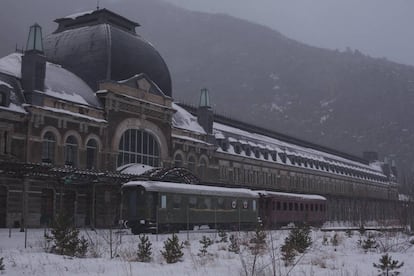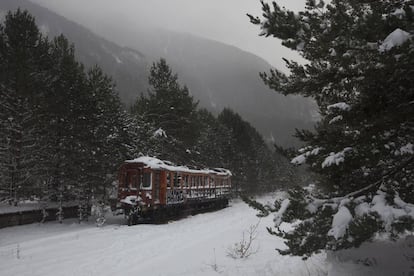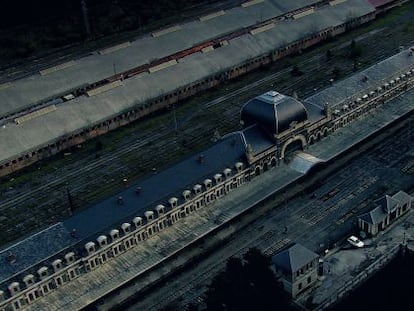The Spanish train station that became a hub for Nazis, gold and spies
Mired in myth, this vast international railway terminal in Huesca was a hotbed of espionage, and a trade route for Spanish tungsten and German loot during the Second World War. Now almost half a century since it closed, there are positive signals of its revival

Canfranc is white, cold and smells of garlic soup and wood smoke. Nestled in the narrow valley in La Jacetania, Huesca, it has 500 residents and one main street, which is split in two by a mammoth railway station that was inaugurated by Alfonso XIII in 1928 and saw its last train pull out for France in 1970. Its history is brief but earned the town international notoriety.
During the Second World War, Spain sent tungsten from here to Nazi Germany for shells and in return, Germany sent Spain gold and jewels. The spot drew an important network of spies who tried to sabotage Nazi operations and help Jewish refugees and Allies enter Spain from occupied Europe.
But all such activity came to a standstill almost half a century ago, replaced by groups of tourists playing in the snow. Most come here to ski in Ast¨²n and Candanch¨². Thanks to them, there is a surprising amount of life in this remote town that was in danger of becoming derelict when the cross-border line was closed. It now has a dozen hotels and lodges, numerous restaurants, a couple of ski shops and four ATMs within meters of each other. It also has a school with around 20 children, a big sports center and an underground scientific facility located in the Somport Tunnel. The part of the town known as Canfranc Station is where the action is. On the other side of the tracks, known as Canfranc Town, there are just 20 inhabitants and a graveyard, where a Jewish refugee is said to lie beside a Nazi general.

In Canfranc, the history of the station is rarely mentioned and while some of the inhabitants have souvenirs from that period, they are either hidden or absorbed into daily life. For example, Mar¨ªa Jos¨¦ Gazapo, 73, who arrived in the town in 1963 as a cook for the local hotel, indicates the tiles on the floor and roof of her house and says: ¡°They are from the station. The builder used material that had been dumped. The same with the moldings.¡±

Then something jogs her memory and she disappears into her loft. Up there, she has dozens of tiles that once belonged to the station, a bag of Republican mail from 1935, an ice bucket from the legendary spy bolthole La Fonda de Marraco, oil lamps and more moldings¡ ¡°The builder left all this here,¡± she says, adding that she has informed the mayor in case they could be used for the station¡¯s possible refurbishment.
The townsfolk appear to be nervous of attracting more attention. The people living here have always known about the station¡¯s history but in 2000 a Frenchman stumbled across a sheaf of papers from between 1942 and 1943, documenting the passage of 86 tons of Nazi gold stolen from the Jews and destined primarily for Portugal. The name Albert Le Lay began to be mentioned ¨C head of the French customs in Canfranc who was a member of the Resistance and helped hundreds of refugees, many of them Jewish, into the country while pretending to collaborate with the Nazis.
What we want is for something to be done now Elisa Torrecillas
¡°At the time, we didn¡¯t think anything of the gold. The repercussions from that came later,¡± says Juli¨¢n Herrezuelo, 93, whose father was a Civil Guard officer working at the station at the time. He adds that the people in the town were more interested in the food that came in on the trains. ¡°My father used to say that the people of Canfranc were capable of removing shoes from a horse as it galloped,¡± he says. ¡°I remember going to the tracks and coming home with my pockets stuffed with sardines¡ The pineapples were delicious. I had to leave everything near the entrance of our house so my mother could get it without my father knowing.¡±
Herrezuelo is accompanied on his stroll to the station by ?ngel S¨¢nchez who, despite the snow, has come out in a light jumper and slip-on shoes. ¡°We came here as children to play because it was the only place that was warm,¡± he says. It is certainly far from warm now. But despite the cold and the fact that only the entrance is open to visitors, 40,000 people a year crowd in to see it for themselves.
During the Second World War, Spain sent tungsten to Nazi Germany for the production?of shells, which Germany paid for in gold
Now, however, various projects are on the table designed to revive its faded grandeur. One entails the relaunch of international train traffic and has just received a grant of €7.5 million from the EU.
According to Jos¨¦ Luis Soro, advisor to the Aragon Regional Government¡¯s Structuring of Territory, Mobility and Property, this summer work will begin on the new station and tracks. ¡°Realistically, they aim to have Canfranc refurbished by 2021,¡± he says. At the same time, the region wants to restore all the installations linked to the railway. ¡°The projects from the 1990s were about maintaining the main building as it is a cultural asset but replace the rest with housing. The current idea is to conserve everything. We have to refurbish what there is and fill it with life and people,¡± says Soro.
What is now a rubble-filled shell will be turned into hotels, restaurants, homes and even a railway museum. And there are also plans for a refuge for pilgrims on the Way of Saint James, thereby encouraging people to undertake this stretch of the route through Aragon. ¡°We are optimistic,¡± says Soro. ¡°At last we are seeing projects take shape.¡±
Soro is not the only optimist. The town¡¯s 500 inhabitants have seen many projects derailed due to lack of money, but the grant from the EU and the work cleaning up the tracks on the French side of the border has been encouraging. ¡°What we want is for something to be done now,¡± says Elisa Torrecillas, who works at the local tourism office. ¡°The station wasn¡¯t built for guided tours. We don¡¯t want the railway to be lost so we are hoping it will be reopened.¡± The train to France had already stopped working by the time she was born, but she has heard all the stories and she is as keen as anyone to see Canfranc back on track.
English version by Heather Galloway.


